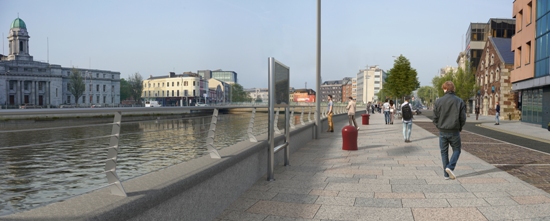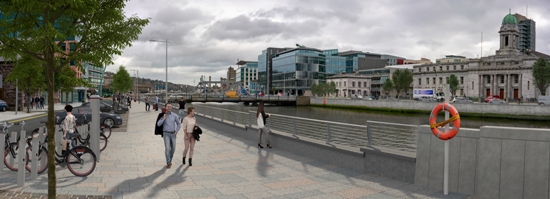New images released of Lower Lee Flood Relief Scheme
The Office of Public Works (OPW) and Cork City Council have published further detail and images of the Lower Lee Flood Relief Scheme LLFRS) which represents the largest State investment in flood defence ever undertaken in the country. This scheme is an important element of the government’s Project Ireland 2040 strategy.

It is hoped that the publication of further detail and images will assuage genuine misunderstanding about the Scheme and also challenge significant misrepresentation of it as well. The various public consultation phases of the project have been very helpful in informing the design of the Scheme which is still evolving. While the Scheme cannot deviate from the comprehensive scientific and empirical analysis on which it is based, it has taken into account many of the suggestions made during the public consultation stages.

The Scheme is the result of over thirteen years of consideration and study of the Lee Catchment and the nature of flooding impacting Cork. As a whole, it extends over approximately 15 Km from west of Ballincollig to the eastern edge of Cork City Centre Island.

Benchmarked against best international practice, the Scheme has involved extensive, peer-reviewed studies and input by engineers, hydrologists, hydraulic experts, ecologists, archaeologists, architectural historians, landscape and conservation architects and hydrogeologists.

The Scheme’ s multifaceted approach takes account of the complexity of flooding in Cork which is both tidal and fluvial (river) and will defend the city against flooding which in 2009 and 2014 caused a reported €140 million damage to households, property and businesses in Cork.


The Scheme’s key elements include a state-of-the-art flood forecasting system which together with revised operating procedures to regulate Inniscarra and Carrigadrohid dams, significantly reduce the peak flow of water reaching the city at times of flood. It involves the creation of washlands to the west of the city, an enhanced early flood warning system, diversion of waters from the south channel into north channel and low-level quay side defences.

"The Scheme will facilitate public realm improvements on a scale not previously seen in Cork city centre, making it more attractive to live in and visit. These improvements which include walkways and cycle ways will encourage a switch from cars to other more environmentally friendly transport modalities," said a spokesperson.

"As a result of the Scheme, The River Lee will be more open for usage through additional access points, pontoons and moorings. Over 900 homes and 1200 businesses will be protected."

About two thirds of public river frontage will have open railings after the Scheme is completed and it will create approximately 8km of new or improved riverside walk and cycleways from the Lee Fields to the City Centre.

There are almost 400 “protected structures” in the city centre’s flood risk area, all of which will be protected by the Scheme.






